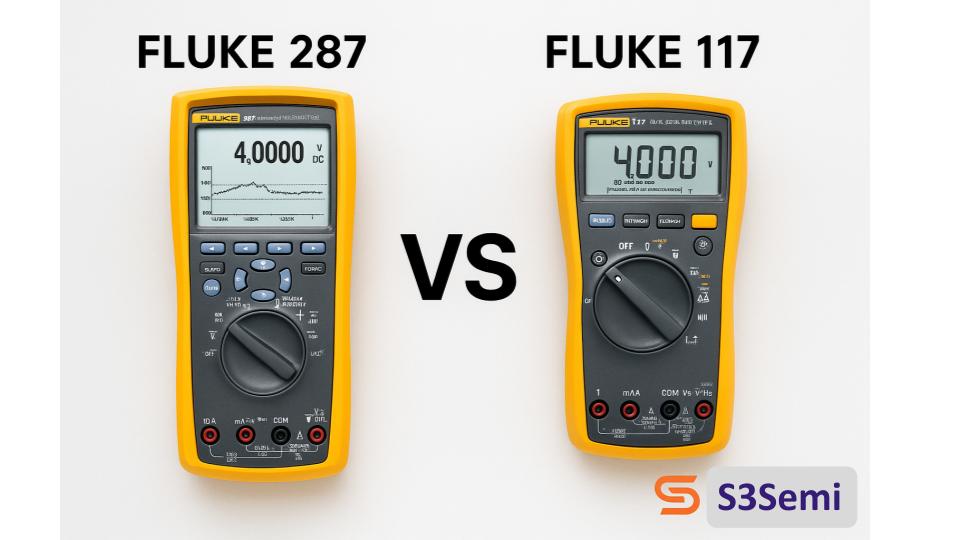Fluke makes some of the most trusted multimeters in the world, and two popular models are the Fluke 287 and the Fluke 117.
🏷️ Fluke Multimeter Deals ⭐⭐⭐⭐
While they share Fluke’s signature accuracy and rugged build, they’re designed for very different users.
Let’s explore how they compare.
📋 Quick Overview
- Fluke 287: A high-end logging and graphing multimeter made for engineers and R&D professionals who need precision and data analysis capabilities.
- Fluke 117: A compact electrician’s multimeter with True-RMS, non-contact voltage detection, and LoZ (low impedance) mode for everyday troubleshooting.
📊 Fluke 287 vs Fluke 117 Comparison Table
| Feature | Fluke 287 | Fluke 117 |
|---|---|---|
| Display | 50,000-count dot-matrix LCD with trend graph | 6000-count LCD with backlight |
| True-RMS | Yes | Yes |
| AC/DC Voltage | Up to 1000V | Up to 600V |
| Current Measurement | Up to 10A | Up to 10A |
| Resistance | Up to 500 MΩ | Up to 40 MΩ |
| Capacitance | Up to 100 mF (100,000 µF) | Up to 9,999 µF |
| Frequency | Up to 1 MHz | Up to 50 kHz |
| 💳 Pricing | 💲Check Price | 💲Check Price |
| Temperature Measurement | Yes (with probe) | No |
| Continuity & Diode Test | Yes | Yes |
| Special Features | Data logging, USB connectivity, onboard graphing | VoltAlert™ non-contact detection, LoZ mode, AutoVolt |
| Safety Rating | CAT III 1000V, CAT IV 600V | CAT III 600V, CAT IV 600V |
| Battery Type | 6 × AA | 9V battery |
| Size & Weight | Larger, ~870 g | Compact, ~550 g |
| Target User | Engineers, R&D, advanced diagnostics | Electricians, commercial/residential wiring |
✅ Pros & Cons of Fluke 287
Pros
- High-resolution display (50,000 counts)
- Advanced logging and graphing directly on the meter
- Extremely wide resistance, capacitance, and frequency ranges
- Data export via USB
- Precision tool for R&D and troubleshooting complex circuits
Cons
- Expensive compared to the 117
- Bulkier and heavier
- Slower response time than compact models
- Overkill for basic electrical work
✅ Pros & Cons of Fluke 117
Pros
- Compact and lightweight
- True-RMS accuracy
- VoltAlert™ non-contact voltage detection
- LoZ mode eliminates ghost voltages
- Affordable compared to Fluke 287
- Ideal for electricians and field service
Cons
- Lower measurement ranges than the 287
- No data logging or graphing features
- No temperature measurement
- Limited to 600V
🛠️ Which One Should You Choose?
- Choose the Fluke 287 if you’re an engineer, R&D professional, or advanced troubleshooter who needs logging, graphing, and lab-grade precision.
- Choose the Fluke 117 if you’re an electrician, technician, or field service professional who needs a fast, reliable, and compact meter for everyday troubleshooting.
In short:
- 287 = Advanced lab and engineering tool
- 117 = Practical electrician’s multimeter




